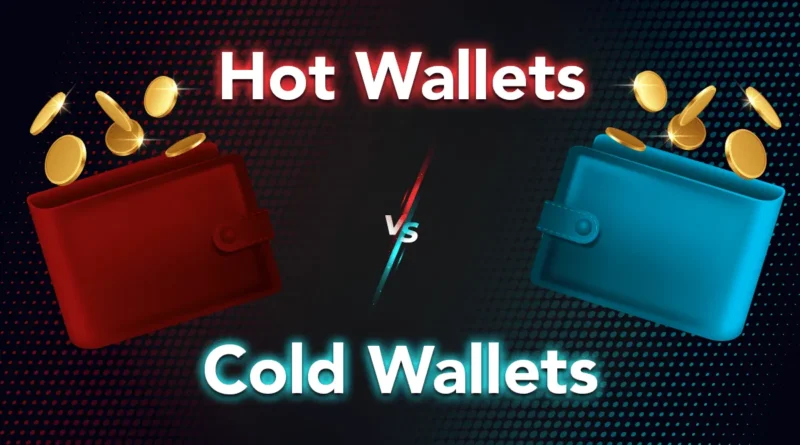Cold Wallets vs. Hot Wallets: Which One Should You Use for Crypto Security in 2025?
Introduction
As the crypto market grows beyond $3 trillion in 2025, securing digital assets is more critical than ever. With hacks and scams costing users over $3.7 billion in 2024 alone, choosing the right wallet is a key decision for investors. Cold wallets and hot wallets offer distinct approaches to storing cryptocurrencies, each with unique strengths and trade-offs. This article compares cold and hot wallets, their features, risks, and how to choose the best option for your crypto security needs in 2025.
What Are Cold Wallets and Hot Wallets?
-
Cold Wallets: These are offline storage solutions, disconnected from the internet, designed to maximize security by minimizing exposure to hacks. Examples include hardware wallets (e.g., Ledger, Trezor) and paper wallets.
-
Hot Wallets: These are online or internet-connected storage solutions, offering convenience for frequent transactions but with higher vulnerability to cyber threats. Examples include mobile apps (e.g., Trust Wallet, MetaMask) and exchange wallets (e.g., Binance, Coinbase).
Both wallet types store private keys—the cryptographic codes needed to access and transfer your crypto—but differ in accessibility, security, and use cases.
Cold Wallets: Features and Benefits
Cold wallets prioritize security by keeping private keys offline, making them nearly impervious to online attacks.
Key Features
-
Offline Storage: Private keys are stored on physical devices (e.g., USB-like hardware wallets) or written on paper, eliminating internet exposure.
-
Hardware Wallets: Devices like Ledger Nano X and Trezor Model T support over 5,000 cryptocurrencies, including Bitcoin, Ethereum, and BRC-20 tokens, with encrypted chips for key storage.
-
Paper Wallets: A printed or written record of private keys and public addresses, often generated via secure offline tools.
-
Recovery Phrases: 12–24 word seed phrases allow wallet restoration if the device is lost or damaged.
-
Multi-Signature Support: Some cold wallets, like Ledger, support multi-sig setups, requiring multiple approvals for transactions.
Benefits
-
High Security: Offline storage protects against hacks, phishing, and malware. In 2025, hardware wallets like Ledger report zero successful remote attacks when properly used.
-
Long-Term Storage: Ideal for hodlers storing large amounts of crypto (e.g., >$10,000) for months or years.
-
Decentralized Control: Users retain full custody of assets, avoiding reliance on centralized exchanges, which saw $1.2 billion in hacks in 2024.
-
Quantum Resistance: Advanced hardware wallets in 2025 incorporate quantum-resistant cryptography, future-proofing against emerging threats.
Drawbacks
-
Inconvenience: Accessing funds requires connecting the device or manually entering keys, slowing down transactions.
-
Upfront Cost: Hardware wallets cost $50–$200 (e.g., Ledger Nano X at $149), unlike free hot wallets.
-
Physical Risks: Devices or paper can be lost, stolen, or damaged, requiring secure storage (e.g., safe deposit boxes).
-
Learning Curve: Setting up and managing seed phrases can be complex for beginners.
Example: A Bitcoin investor with 1 BTC ($80,000 in 2025) uses a Trezor Model T to store funds offline, minimizing risks from exchange hacks like the $200 million KuCoin breach in 2020.
Hot Wallets: Features and Benefits
Hot wallets prioritize accessibility, making them suitable for active traders and frequent transactions.
Key Features
-
Online Accessibility: Available via mobile apps, browser extensions (e.g., MetaMask), or exchange platforms, enabling instant access to funds.
-
Wide Compatibility: Support thousands of tokens across blockchains like Ethereum, Solana, and Binance Smart Chain.
-
Integration with dApps: Hot wallets like Trust Wallet connect seamlessly to DeFi platforms (e.g., Uniswap) and NFT marketplaces (e.g., OpenSea).
-
Free or Low Cost: Most hot wallets are free, with exchange wallets integrated into platforms like Coinbase.
Benefits
-
Convenience: Instant access to funds for trading, staking, or DeFi participation, ideal for daily use.
-
User-Friendly: Mobile apps like Coinbase Wallet offer intuitive interfaces, even for beginners.
-
Liquidity: Exchange wallets enable quick conversions to fiat or other cryptocurrencies, supporting $100 billion in daily trading volume in 2025.
-
Staking and Yield Farming: Hot wallets like MetaMask allow users to stake assets (e.g., 4–6% APY on Cardano) or participate in DeFi protocols directly.
Also Read: What Is a Multisig Wallet?
Drawbacks
-
Security Risks: Internet connectivity exposes hot wallets to hacks, phishing, and malware. In 2024, over $1.5 billion was lost to hot wallet exploits.
-
Centralized Vulnerabilities: Exchange wallets rely on third-party security, with risks of insolvency or hacks (e.g., FTX’s $8 billion collapse in 2022).
-
Private Key Exposure: Some hot wallets store keys on servers, reducing user control.
-
Regulatory Risks: Exchange wallets may freeze funds due to compliance issues, as seen in Binance’s $4.3 billion settlement in 2024.
Example: A DeFi trader uses MetaMask to swap $500 worth of ETH on Uniswap and stake SOL on Solana, benefiting from instant access but taking precautions like two-factor authentication (2FA).
Comparing Cold Wallets and Hot Wallets
|
Feature |
Cold Wallets |
Hot Wallets |
|---|---|---|
|
Security |
High (offline, hack-resistant) |
Moderate (vulnerable to online threats) |
|
Accessibility |
Low (requires manual setup) |
High (instant access via apps) |
|
Cost |
$50–$200 (hardware) |
Free or low cost |
|
Use Case |
Long-term storage, large holdings |
Active trading, DeFi, daily use |
|
Supported Assets |
Thousands (BTC, ETH, etc.) |
Thousands, including dApp tokens |
|
Risks |
Physical loss, user error |
Hacks, phishing, platform failure |
Which Wallet Should You Use in 2025?
Choosing between cold and hot wallets depends on your goals, risk tolerance, and investment habits:
Use a Cold Wallet If:
-
You hold significant crypto assets (e.g., >$10,000) for long-term investment.
-
Security is your top priority, and you’re comfortable with offline storage.
-
You want full custody of your private keys, avoiding third-party risks.
-
You’re concerned about quantum computing risks, as advanced hardware wallets offer quantum-resistant options.
Recommended Options:
-
Ledger Nano X: Supports 5,500+ tokens, Bluetooth connectivity, and multi-sig ($149).
-
Trezor Model T: Open-source, touchscreen interface, and quantum-resistant cryptography ($179).
-
Paper Wallets: Free but require secure generation (e.g., via Bitaddress.org offline).
Use a Hot Wallet If:
-
You trade frequently or participate in DeFi, NFTs, or staking.
-
You need quick access to funds for transactions or dApp interactions.
-
You’re comfortable with basic security practices like 2FA and seed phrase backups.
-
You’re managing smaller amounts (e.g., <$5,000) where convenience outweighs risk.
Recommended Options:
-
MetaMask: Browser/mobile wallet for Ethereum and EVM-compatible chains, ideal for DeFi.
-
Trust Wallet: Supports 70+ blockchains, user-friendly for mobile users.
-
Coinbase Wallet: Non-custodial, integrated with Coinbase for easy fiat conversions.
Hybrid Approach
Many investors use both wallet types:
-
Cold Wallet for Storage: Store 80–90% of your portfolio in a cold wallet for security.
-
Hot Wallet for Trading: Keep 10–20% in a hot wallet for active trading or DeFi.
-
Example: An investor stores 2 BTC ($160,000) in a Ledger Nano X and $2,000 in MetaMask for Uniswap trades, balancing security and accessibility.
Best Practices for Crypto Security in 2025
-
Secure Your Seed Phrase: Store your 12–24 word recovery phrase offline (e.g., in a safe or engraved on metal). Never store it digitally or share it.
-
Use Strong Authentication: Enable 2FA (preferably hardware-based, like YubiKey) on hot wallets and exchange accounts.
-
Verify Transactions: Double-check wallet addresses and dApp permissions to avoid phishing scams, which affected 1.3 million users in 2024.
-
Update Software: Keep hot wallet apps and hardware wallet firmware updated to patch vulnerabilities.
-
Diversify Storage: Split large holdings across multiple wallets to reduce single-point-of-failure risks.
-
Avoid Public Wi-Fi: When using hot wallets, avoid unsecured networks to prevent man-in-the-middle attacks.
-
Monitor Activity: Use block explorers (e.g., Etherscan, BscScan) to track wallet transactions for suspicious activity.
Challenges and Considerations
-
Cold Wallet Risks: Physical loss or damage (e.g., fire, theft) can render funds inaccessible without a seed phrase backup. User error, like improper setup, caused $100 million in losses in 2024.
-
Hot Wallet Vulnerabilities: Phishing attacks and smart contract exploits remain prevalent. In 2025, over 50% of DeFi hacks target hot wallet users.
-
Cost vs. Benefit: Hardware wallets’ upfront costs may deter small investors, but their security outweighs losses from hacks.
-
Evolving Threats: Quantum computing advancements may challenge older wallet cryptography, though 2025 hardware wallets are increasingly quantum-resistant.
Conclusion
Cold wallets and hot wallets serve distinct purposes in securing cryptocurrencies in 2025. Cold wallets, like Ledger and Trezor, offer unmatched security for long-term storage, ideal for large holdings or risk-averse investors. Hot wallets, such as MetaMask and Trust Wallet, provide convenience for active trading and DeFi participation but require vigilant security practices. By understanding their strengths and risks, and adopting a hybrid approach, investors can protect their assets while navigating the dynamic crypto market. Choosing the right wallet depends on your investment goals, technical comfort, and the balance between security and accessibility.




